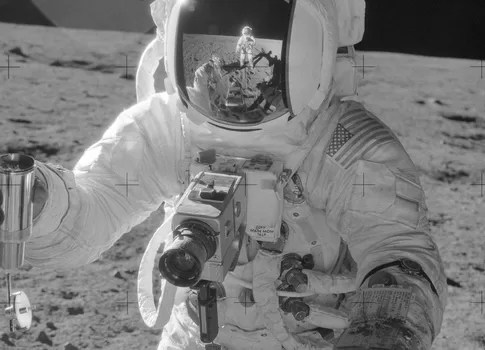Astronauts used the world-renowned Hasselblad camera on the moon. The name Hasselblad is synonymous with exceptional quality in the world of photography, but its legacy extends far beyond Earth. The Swedish camera manufacturer has an out-of-this-world reputation, quite literally, thanks to its role in one of humanity’s greatest achievements: the Apollo moon landings.
Advertisement:
As of the last Apollo mission, twelve Hasselblad cameras remain on the moon. These cameras were left behind by the astronauts to save weight on the return journey, as they prioritized bringing back moon rock samples and other scientific equipment.
The astronauts only brought back the 70mm film magazines containing the invaluable mylar-based Kodak Ektachrome film taken during their missions.

The photo above is the modified Hasselblad used in the Apollo 11 command module during the historic first manned trip to the moon. NASA transferred this camera to the National Air and Space Museum in 1970.
These cameras, now historical artifacts, are scattered across various Apollo landing sites, evidence of the remarkable achievements of the Apollo program and Hasselblad’s significant contribution to space exploration.
From Amazon: Photography equipment and techniques; a survey of NASA developments, by Albert J. Derr 1972 [Leather Bound]
A list of images taken during the Apollo missions in space is in the 70mm Hasselblad Image Catalog.
Advertisement:
The Beginning of a Stellar Partnership
In the early 1960s, NASA was in search of a camera that could withstand the harsh conditions of space while delivering high-quality images.
The Apollo program was gearing up to send astronauts to the moon, and documenting this monumental endeavor was crucial. Enter the Hasselblad 500C, a medium format camera that had already proven its worth on Earth.
NASA’s interest in Hasselblad was sparked by the impeccable build quality and superior image resolution of the 500C.
After some modifications to meet the stringent requirements of space travel, including the removal of leather coverings and the addition of larger control buttons for use with spacesuit gloves, the camera was ready for its mission.

A Camera for the Cosmos
The first modified Hasselblad, a 500EL, accompanied astronaut Wally Schirra on the Mercury-Atlas 8 mission in 1962.
A new film magazine was designed to accommodate 70 exposures instead of the usual 12. A matte black exterior finish was applied to minimize reflections in the orbiter’s window.
The success of this flight marked the beginning of a long and fruitful collaboration between NASA and Hasselblad. The camera’s reliability and performance under extreme conditions were further tested and refined during the Gemini missions.
Advertisement:
Apollo 11: A Giant Leap for Hasselblad
The pinnacle of Hasselblad’s space odyssey came with the Apollo 11 mission in 1969. As Neil Armstrong and Buzz Aldrin made history by becoming the first humans to set foot on the moon, the Hasselblad cameras they carried captured some of the most iconic images ever taken.
The camera used on the lunar surface was a specially modified Hasselblad Data Camera (HDC), designed to operate in the moon’s challenging environment.

One of the most famous photographs taken with a Hasselblad on the moon is the image of Buzz Aldrin, with the reflection of the lunar module and Neil Armstrong visible in his visor.
This photograph, along with many others taken during the Apollo missions, provided the world with breathtaking visuals of the moon and became symbols of human achievement.
Technical Marvels of the Hasselblad Data Camera
The Hasselblad Data Camera used during the Apollo missions featured several modifications to make it suitable for lunar photography.
A glass plate with crosshair markers, known as a reseau plate, was placed in front of the film to provide precise reference points, essential for scientific measurements.
The cameras used a special thin-base film that allowed for more exposures per roll, maximizing the number of photographs that could be taken during each mission.
They were given a silver metallic finish to help maintain thermal stability in the extreme temperatures of the lunar surface, and the controls were simplified to ensure ease of use while wearing bulky space gloves.


Apollo 11 © NASA 1969
The Lenses of Hasselblad Cameras on the Moon
The Hasselblad cameras left on the moon during the Apollo missions were equipped with specialized lenses, meticulously chosen and modified to handle the unique challenges of lunar photography.
These lenses played a crucial role in capturing the extraordinary images that documented humanity’s first steps on the lunar surface.
Zeiss Biogon 60mm f/5.6 Lens
The Zeiss Biogon 60mm f/5.6 lens was a wide-angle lens used extensively for general lunar surface photography. Its broad field of view was perfect for capturing the expansive lunar landscapes, ensuring that astronauts could document their surroundings comprehensively.
The wide-angle perspective allowed for more context in each shot, making it possible to include both the astronauts and their activities within the lunar environment.
Zeiss Planar 80mm f/2.8 Lens
Another essential lens used during the Apollo missions was the Zeiss Planar 80mm f/2.8. This standard lens was incredibly versatile, suitable for a variety of photographic needs, including both medium-distance and closer subjects.
Known for its sharpness and clarity, the Planar 80mm was critical for scientific documentation, allowing for detailed and high-quality images. This lens was often used to capture portraits of astronauts, as well as detailed shots of equipment and lunar samples.
Zeiss Sonnar 250mm f/5.6 Lens
For capturing distant objects on the lunar surface, the Zeiss Sonnar 250mm f/5.6 lens was employed. This telephoto lens allowed astronauts to take detailed photographs of specific lunar features or experiments from a distance.
Its ability to bring distant subjects into sharp focus was essential for documenting the broader lunar landscape, geological features, and equipment set up far from the lunar module.
Modifications for Lunar Photography
The lenses used on the moon were specially modified to withstand the harsh lunar environment.
These modifications ensured that the lenses could operate in extreme temperatures, resist the vacuum of space, and be easily handled by astronauts wearing bulky space gloves.
The combination of these specialized lenses with the Hasselblad cameras was vital in capturing the iconic images of the moon landings.
These images have not only documented a pivotal moment in human history but have also fascinated and inspired generations around the world.
The specialized lenses of the Hasselblad cameras left on the moon were integral to the success of lunar photography during the Apollo missions.
The Zeiss Biogon 60mm, Planar 80mm, and Sonnar 250mm lenses each played a unique role in capturing the breathtaking and historic images of the moon.
These lenses, along with the Hasselblad cameras, remain on the lunar surface.

Advertisement:
The Film Used in Hasselblad Cameras on the Moon
The choice of film was a crucial aspect of the lunar photography undertaken during the Apollo missions. The film needed to withstand extreme conditions while delivering the highest quality images.
Here’s a detailed look at the film used in the Hasselblad cameras on the moon:
Special Thin-Base Film
The film used in the Hasselblad cameras during the Apollo missions was a specially designed thin-base film.
This type of film was chosen because its thinner base allowed for more exposures per roll, which was essential given the limited opportunities for changing film during a lunar mission.
The thin-base film enabled astronauts to maximize the number of photographs they could take without adding excessive weight to their gear.
Kodak Ektachrome 160 (E-3)
One of the primary films used was Kodak Ektachrome 160 (E-3), a color reversal film known for its fine grain and excellent color reproduction.
This film was particularly suitable for capturing the vibrant and contrasting colors of the lunar surface and the astronauts’ activities. The Ektachrome 160 was chosen for its ability to produce high-quality images under the challenging lighting conditions on the moon.
Kodak Panatomic-X
For black-and-white photography, Kodak Panatomic-X was used. This film had an ISO rating of 80, offering very fine grain and high resolution, which was ideal for scientific and detailed photographic documentation.
The Panatomic-X film captured sharp, high-contrast images, making it suitable for detailed analysis of the lunar surface and the equipment used during the missions.

Special Considerations
The films used were specially prepared to endure the extreme conditions of space, including wide temperature fluctuations and radiation exposure. The film magazines were also designed to be easily handled by astronauts wearing bulky space gloves.
To ensure the film could capture the necessary details, the cameras were often preset to specific exposure settings based on extensive pre-mission testing.
The choice of film for the Hasselblad cameras used on the moon was a critical factor in the success of lunar photography during the Apollo missions.
The Kodak Ektachrome 160 and Kodak Panatomic-X films provided the necessary quality and reliability to document this historic achievement.
The images captured on these films remain some of the most iconic and scientifically valuable photographs ever taken, showcasing the moon’s surface and the monumental efforts of the Apollo missions.
A camera said to have been used on the moon’s surface sold for nearly $1 million at an auction in 2014, despite doubts about its authenticity.

The Legacy of Hasselblad’s Lunar Adventures
Hasselblad’s contributions to space exploration did not end with the Apollo program. The cameras continued to be used in subsequent space missions, including the Skylab program and the Space Shuttle missions.
The enduring partnership between NASA and Hasselblad has solidified the brand’s reputation as a maker of exceptional cameras capable of capturing the extraordinary.
The journey of Hasselblad cameras from the studios and landscapes of Earth to the surface of the moon is a testament to the brand’s dedication to quality and innovation.
The iconic images taken with Hasselblad cameras during the Apollo missions have not only documented a pivotal moment in human history but have also inspired generations of photographers and space enthusiasts alike.
As we look to the future of space exploration, the legacy of Hasselblad on the moon serves as a reminder of the incredible achievements that can be realized when technology and human ingenuity come together.
Further Reading
From Amazon: Photography equipment and techniques; a survey of NASA developments, by Albert J. Derr 1972 [Leather Bound]
Related stories
NASA’s Famous Blue Marble Photo Is 50 Years Old
Australia-US Space Launches Agreement Examined
Rolleiflex vs Hasselblad film cameras?
Astronaut Bruce McCandless: One “Big Leap” For Man
Lunar Agriculture: Plants to be Grown on the Moon
Hasselblad 907X & CFV 100C – A Medium Format Camera Marvel
Hasselblad camera ° medium format film camera
Advertisement:




